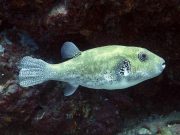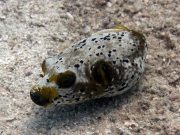Dykning med Pufferfisk
Koh Lantas Marineliv | Tetraodontidae
Kuglefisk er et almindeligt syn på alle koralrev under dykkerture på Koh Lanta. De har typisk runde ansigter, tilspidsede kroppe og store øjne og varierer i størrelse fra 2 cm til omkring 1 m i længden. Pufferfisk er lette at få øje på, når man dykker omkring Koh Lanta, men de er en af de mest giftige fisk i havet og bør ikke spises.
Pufferfisk har evnen til at sluge vand og undertiden luft for at puste deres kroppe op til en kæmpe kugle, når de føler sig truet. Man mener, at de har udviklet denne taktik som en metode til selvforsvar, da de er meget dårlige til at svømme.
Et rovdyr, der formår at fange en pufferfisk, før den puster sig op, vil ikke føle sig heldig ret længe. Næsten alle pufferfisk indeholder 'tetrodotoxin', et giftstof, der gør dem dødelige for de fleste rovdyr. Det findes i deres organer, hud og pigge, afhængigt af arten. Kun få dyr er immune over for toksinet, såsom hajer og havslanger. For mennesker er det dødeligt, op til 1.200 gange mere giftigt end cyanid, og da der ikke findes nogen kendt modgift, er der nok toksin i en pufferfisk til at dræbe 30 voksne mennesker!
Pufferfisk har tætpakkede tænder, der giver dem et sammenvokset, næbagtigt udseende. Disse meget skarpe tænder bruges til at bryde bløddyr op, spise hvirvelløse dyr og skrabe alger. Man mener, at de syntetiserer deres dødbringende gift fra bakterierne i deres føde.
Når en pufferfisk når modenhed, fører hannen hunnen tæt på kysten, hvor de udskiller og befrugter kun 3-7 æg. Ungerne bliver her, indtil de er store nok til at slutte sig til revet.
5 arter fundet på denne side:
Blackspotted Pufferfish
(Arothron nigropunctatus)
The blackspotted, or dog-face puffer is a common sight at all of our dive sites and easy to identify. This small fish has no scales and grows up to 33 cm, but more commonly observed around 20 cm. Sometimes seen alone, sometimes in pairs. This fish has a short snout, no pelvic fin and both a small dorsal and anal fin.

Arothron nigropunctatus @ Koh Haa
Blackspotted pufferfish colouration is highly variable, greyish, bluish, blackish, yellowish, however they all have a few common markings such as black lips, black around the pectoral fin base and scatterings of different sized black spots on the body.
Instead of "teeth," blackspotted puffers have 4 strong teeth in a beak-like structure which they use to crush crustaceans and mollusks, crunch sponges and the tips of branching corals.
Starry Pufferfish
(Arothron stellatus)

Arothron stellatus @ Koh Haa
The starry pufferfish is the largest of all puffers, growing up to 1.2m. This fish has no scales, with the body covered with prickles. This fish has a short snout, no pelvic fin and both a small dorsal and anal fin.
Adults are white with many small black spots, juveniles have fewer, larger spots. Young fish are orange with small black spots and black stripes on the belly, becoming spots as they age.
Usually seen alone, the starry puffer feeds on sea urchins, starfish, sponges, crabs, corals and algae. Sometimes seen swimming high above the corals or seabed. The starry puffer is extremely poisonous, and tetrodotoxin may occur in the muscle, intestine, liver, gonads and skin. Do not try to eat this fish.
Blue-spot Pufferfish
(Arothron caeruleopunctatus)

Arothron caeruleopunctatus @ Koh Haa
The Blue-spot Pufferfish has a yellowish, brown to grey back, lighter below, and covered in small white to blue spots.
There are alternating dark and light rings around the eyes, and the pectoral fin base has a black patch with white spots.
As with other Pufferfishes, the Blue-spot Pufferfish has a small dorsal and anal fin and the teeth are fused into four beak-like parts. The Blue-spot Pufferfish grows to 70 cm.
Scribbled Pufferfish
(Arothron mappa)

Arothron mappa @ Koh Haa
The scribbled, or 'map' puffer is a medium size fish growing up to 65 cm, but often observed smaller than this.
The background coloration is whitish with dense network of black broken lines and lines radiating from the eyes.
The scribbled pufferfish has a large black blotch around the gill opening, and a black blotch on the lower side.
As with the other puffers listed here, this fish has no scales, with the body covered with prickles.
This fish has a short snout, four beak-like teeth, no pelvic fin and both a small dorsal and anal fin. It is also highly toxic.
Spotted Toby
(Canthigaster solandri)

Canthigaster solandri @ Koh Haa
The Spotted Toby has a brownish body colour, covered with white to blue to green spots.
There are white to blue to green line markings on the snout and back. There is on ocellated spot on the dorsal fin base.
The Spotted Toby grows to 10 cm and is found in sheltered reef areas and often found in pairs.
The Spotted Toby fish feeds on algae, coral polyps and bottom-dwelling invertebrates such as molluscs (slugs & snails), echinoderms (sea urchins, sea stars) and polychaetes (bristle worms).
Dykning med Pufferfisk omkring Koh Lanta
Dykning og snorkelture
Hvis du gerne vil have chancen for at se Pufferfisk på en af vores daglige dykkerture i højsæsonen fra Koh Lanta, så send os en e-mail til info@diveandrelax.com.
Deltag i vores speedbådsdykkerture i højsæsonen til nogle af Thailands bedste dykkersteder og nyd små grupper, korte rejsetider med fokus på god personlig service, sikkerhed og sjov.
Er du endnu ikke certificeret dykker? Lær at dykke på Koh Lanta med det 3-dages SSI Open Water Diver-kursus.
Book online og spar 10% på dykkerture og dykkerkurser på Koh Lanta.
Få mere at vide
Indo-Stillehavets havdyrsguider
- Allen, G., Steene, R., Humann, P., DeLoach, N. (2003) Reef Fish Identification, Tropical Pacific. Jacksonville, FL., USA: New World Publications, Inc., ISBN 1-878348-36-1.
- Humann, P., DeLoach, N., (2010) Reef Creature Identification, Tropical Pacific. Jacksonville, FL., USA: New World Publications Inc., ISBN 978-1-878348-44-9
- Debelius, H. (2013) Indian Ocean Reef Guide. Frankfurt, Germany: IKAN - Unterwasserarchiv, ISBN 978-3-939767-52-7.
- Debelius, H. (2004) Nudibranchs and Sea Snails, Indo-Pacific Field Guide. Frankfurt, Germany: IKAN - Unterwasserarchiv, ISBN 3-925919-51-1
- Erhardt, H., Knop, D. (2015) Corals Indo-Pacific Field Guide. Frankfurt, Germany: IKAN - Unterwasserarchiv, ISBN 3-925919-69-4.
- Veron J.E.N., Stafford-Smith M.G., Turak E. and DeVantier L.M. (2016). Corals of the World
Flere referencer om havets dyreliv og yderligere information


